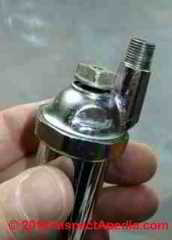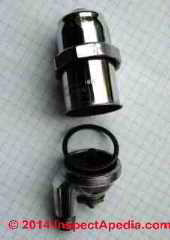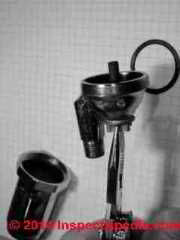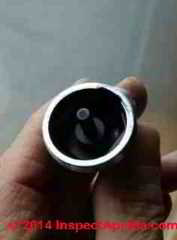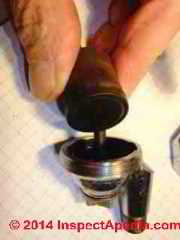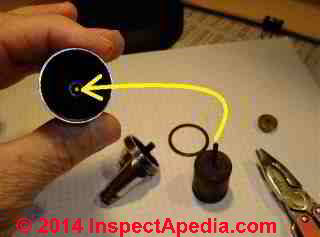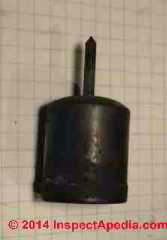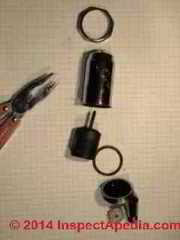 Steam Radiator Vent Disassembly & Repair
Steam Radiator Vent Disassembly & Repair
Steps in taking a steam radiator vent apart to repair or adjust it before throwing it away and installing a new one
- POST a QUESTION or COMMENT about steam radiator vent disassembly, repair, replacement, or operation
Steam radiator vent repair or parts replacement, disassembly, inspection, repair or replacement:
Using annotated photographs we disassemble an adjustable Vent-Rite NO. 51 one pipe steam radiator vent to see what's inside, to look for repairable or clean-able components, and to decide if the vent should be repaired or just replaced.
Let's be clear: the least troublesome and fastest repair is to just replace a bad-behaving steam vent. But if you are determined to try cleaning a steam radiator vent or if you just want an up close look at what's inside, this article will be fun.
InspectAPedia tolerates no conflicts of interest. We have no relationship with advertisers, products, or services discussed at this website.
- Daniel Friedman, Publisher/Editor/Author - See WHO ARE WE?
Taking Apart an Adjustable Steam Vent from Vent-Rite - the Vent-Rite No 51
 When this Vent-Rite steam vent, No. 51 (that you'll have trouble even finding online) stopped working the owner had tried adjusting the vent rate using the adjustable nut on the vent bottom. But the vent no longer worked, probably because its float had developed a leak.
When this Vent-Rite steam vent, No. 51 (that you'll have trouble even finding online) stopped working the owner had tried adjusting the vent rate using the adjustable nut on the vent bottom. But the vent no longer worked, probably because its float had developed a leak.
We disassembled the unit to show the hidden parts and thus the secrets of the Vent-Rite steam radiator vent in a series of images given here.
[Click to enlarge any image]
Watch out: it may be possible to get a bad steam radiator vent or steam main line vent working again by simple cleaning without disassembly. To try that approach
see STEAM RADIATOR VENT CLEAN & TEST
At above left you see the Vent-Rite No. 51 adjustable steam radiator valve before I destroyed it. At above right you can see the vent opening in the valve top.
This opening vents air when the radiator is cold, and as the radiator heats and the vent closes, things should get quiet and the valve stops venting.
Thanks to reader Paul Ruud for discussing improved steam heat controls and thermostatically operated steam radiator valves and air vents and for providing the steam radiator vent that we disassembled for these photographs.
 Some steam may vent before the valve closes. But if the vent never closes and keeps blowing steam or perhaps a mix of steam and condensate ("steam vent spitting") something's wrong.
Some steam may vent before the valve closes. But if the vent never closes and keeps blowing steam or perhaps a mix of steam and condensate ("steam vent spitting") something's wrong.
Most likely the internal valve seat is dirty or damaged and won't seal or the internal thermostatic float in the valve is defective - it's time replace the steam vent.
Watch out: steam can cause serious burns and steam condensate can be burning hot as well as a source of building water damage. Do not try to work on live steam or hot steam heating radiators and vents. Turn off and cool down the system before touching anything.
These notes and photographs are for purpose of illustration. While swapping out a steam vent for a new one is simple enough that with some caution a homeowner can attempt the task, in most cases repairs on steam heating systems are best performed by a trained service technician.
At below left I give a close-up of the Vent-Rite adjustment nut that we thought might change the vent operation - but it didn't.
We decided to look inside, figuring if the vent is broken and is going to be replace anyway there's nothing to lose in tearing an old one apart for the sake of science.
Start by holding the vent bottom with a wrench and using a larger wrench to turn the nut I'm pinching with my fingers (below right).
Now we're getting someplace.
At below left you can see the Vent-Rite top and bottom sections have been separated; a copper gasket is used at this mating joint and I've slipped the nut half-way up the vent body.
If you are indulging in the fantasy that you can clean and restore this valve to service, press on, but remember I told you to just go ahead and buy and install a new one on the radiator before messing with the old valve.
Above I'm holding the vent adjustment nut with pliers and you can see that if it did anything, that nut would move the plunger in or out to press more or less against the bottom of the Vent-Rite's internal float.
Below you can see the plunger working end.
Below in this next photo I'm showing how the adjustable plunger, by moving in or out of the vent body, would make the vent's internal float start at a higher or lower position inside the vent body.
Why we care about the float position will be shown next.
OK so here's how this vent works to open or close the steam vent on a radiator. If the float rises its tapered point pushes against an opening in the top of the valve body to stop steam from escaping. If the float falls it opens the vent.
The vent will close either thermostatically (it gets hot and the float pushes up and closes the opening in the vent top) or by floating upwards should actual condensate (water) fill the float body. Just follow the yellow arrow.
Now we know why a steam vent might "spit" water: its top opening is not closing fully AND the radiator has a lot of condensate inside.
Just below we show a close-up of the actual steam radiator vent float and its tapered tip.
In this next photo below we show the steam radiator vent disassembled but with its parts in order - more or less.
From the bottom up is the adjustment nut, the valve base containing its internal plunger, gasket, vent float, vent top body that includes a vent orifice at its top, and a large ring nut that secures the vent body top to its base.
Steam radiator vent repair versus replacement
If you are a tinkerer or if you are desperate to try to get a recalcitrant steam vent working and don't have a replacement at hand (replacement is still our best advice), you might want to try disassembling the steam vent and then cleaning the valve seat or float pin in a steam radiator vent.
Details of how to do this steam vent disassembly are at the start of the article above on this page
But really for most repair technicians or building occupants or owners you'd be better off just replacing the steam valve if simple cleaning (described in a separate article
at STEAM RADIATOR VENT CLEAN & TEST did not work) didn't work: it's often not worth the time and trouble to actually disassemble the steam vent, especially since there's a good chance that if the valve no longer opens or closes when it should it's the float itself that's at fault.
Given the trouble of cleaning and reassembling and reinstalling the valve, then bringing up the heat to watch the valve to see if it works, the disappointment when it doesn't, and the muttering, to me it makes sense to just go ahead and replace the steam vent with a new unit.
...
Continue reading at STEAM VENTS, 1-PIPE SYSTEMS or select a topic from the closely-related articles below, or see the complete ARTICLE INDEX.
Or see these
Recommended Articles
- BOILER CONTROLS & SWITCHES
- STEAM HEAT RADIATOR REPAIR
- RADIATOR VALVES & HEAT CONTROLS
- STEAM TRAPS
- STEAM VENTS - home
Suggested citation for this web page
STEAM RADIATOR VENT REPAIR at InspectApedia.com - online encyclopedia of building & environmental inspection, testing, diagnosis, repair, & problem prevention advice.
Or see this
INDEX to RELATED ARTICLES: ARTICLE INDEX to STEAM BOILERS
Or use the SEARCH BOX found below to Ask a Question or Search InspectApedia
Ask a Question or Search InspectApedia
Try the search box just below, or if you prefer, post a question or comment in the Comments box below and we will respond promptly.
Search the InspectApedia website
Note: appearance of your Comment below may be delayed: if your comment contains an image, photograph, web link, or text that looks to the software as if it might be a web link, your posting will appear after it has been approved by a moderator. Apologies for the delay.
Only one image can be added per comment but you can post as many comments, and therefore images, as you like.
You will not receive a notification when a response to your question has been posted.
Please bookmark this page to make it easy for you to check back for our response.
IF above you see "Comment Form is loading comments..." then COMMENT BOX - countable.ca / bawkbox.com IS NOT WORKING.
In any case you are welcome to send an email directly to us at InspectApedia.com at editor@inspectApedia.com
We'll reply to you directly. Please help us help you by noting, in your email, the URL of the InspectApedia page where you wanted to comment.
Citations & References
In addition to any citations in the article above, a full list is available on request.
- Honeywell Corporation, Tel: U.S. 1 (877) 841-2840, International 001 (480) 353-3020, Website: www.honeywell.com
- Vent-Rite Valve Corporation: 1875 Dewey Ave. Benton Harbor, MI 49022 TEL: (269) 925-8818 FAX: (269) 925-7888
- Emerson Swan, Inc. 300 Pond Street Randolph, MA 02368 Tel: (781) 986-2000 Fax: (781) 986-2028 info@emersonswan.com
- Barnes & Jones Corporation, 91 Pacella Park Drive Randolph, MA 02368, Tel: 781-963-8000calibrated steam traps and vents, Email: bnesbitt@barnesandjones.com. Vent-Rite steam vents for radiator control.
- Gorton Heating Corporation, 546 South Avenue East, Cranford, New Jersey 07016, Tel: 908-276-1323, email: info@gorton-valves.com, fast venting valves for steam heating systems.
- "Rv-4 One-Pipe Steam Radiator Valve", available from Armstrong International,
816 Maple Street, Three Rivers, MI 49093 USA, Tel: (269) 273-1415, Armstrong has offices in Beijing, China, Belgium, India and Mexico. Web search 12/27/2010, original source:
http://www.armstronginternational.com/thermostatic-valves-rv-4-one-pipe. - "Special Steam Vents", Hoffman Specialty heating products, web search 12/27/2010, original source:
http://www.hoffmanspecialty.com/pdf/hs900/HS900-3474.pdf - "Steam and Water Vents, Selection Guidelines - Steam Vents", Hoffman Specialty, web search 12/27/2010, original source:
http://www.hoffmanspecialty.com/pdf/hs900/HS900-stvents.pdf - Hoffman 1A adjustable steam vents, available from Hoffman Specialty, ITT, web search 12/27/2010, original source:
http://www.drillspot.com/products/51570/Hoffman_1A_Adjustable_Automatic_Air_Vent_For_Steam_Radiators - Hoffman Convector Steam Vents, available from Hoffman Specialty, ITT, web search 12/28/2010, original source:
http://www.hoffmanspecialty.com/pdf/hs900/HS900-conv109.pdf - Report 95-14, PB96-198163 Thermostatic Radiator Valve (TRV) Demonstration Project, contact NYSERDA. 17 Columbia Circle, Albany, NY 12203-6399 Toll-Free: 1-866-NYSERDA, Tel:(518)465-6252, Ext. 241. Web Search 12/27/2010, original source: http://www.homeenergy.org/archive/hem.dis.anl.gov/eehem/96/960509.html
- VariValve® Quick-Vent from Heat Timer, adjustable radiator and main line vent valves for one pipe steam systems, web search 12/27/2010, original source: http://www.heat-timer.com/enFiles/ProductDocument/literature/VariV056082C.pdf
- "Care & Feeding of Air Vents", Dan Holohan, Old House Journal Online, November 2004
- The Steam Book, 1984, Training and Education Department, Fluid Handling Division, ITT [probably out of print, possibly available from several home inspection supply companies] Fuel Oil and Oil Heat Magazine, October 1990, offers an update, (see next item in this list). ITT Fluid Technology,
1133 Westchester Avenue
White Plains, NY 10604, tel +1 914 304 1700 fax +1 914 696 2950 www.ittfluidbusiness.com - Principles of Steam Heating, $13.25 includes postage. Fuel oil & Oil Heat Magazine, 389 Passaic Ave., Fairfield, NJ 07004.
- The Lost Art of Steam Heating, Dan Holohan, 516-579-3046 FAX
- Principles of Steam Heating, Dan Holohan, technical editor of Fuel Oil and Oil Heat magazine, 389 Passaic Ave., Fairfield, NJ 07004 ($12.+1.25 postage/handling).
- "Residential Steam Heating Systems", Instructional Technologies Institute, Inc., 145 "D" Grassy Plain St., Bethel, CT 06801 800/227-1663 [home inspection training material] 1987
- The Heat Efficiency of Steam Boilers, Bryan Donkin
- Steam Boiler Operation, Principles & Practice, James J. Jackson
- The Steam Book, 1984, Training and Education Department, Fluid Handling Division, ITT [probably out of print, possibly available from several home inspection supply companies] Fuel Oil and Oil Heat Magazine, October 1990, offers an update,
- Principles of Steam Heating, $13.25 includes postage. Fuel oil & Oil Heat Magazine, 389 Passaic Ave., Fairfield, NJ 07004.
- The Lost Art of Steam Heating, Dan Holohan, 516-579-3046 FAX
- Principles of Steam Heating, Dan Holohan, technical editor of Fuel Oil and Oil Heat magazine, 389 Passaic Ave., Fairfield, NJ 07004 ($12.+1.25 postage/handling).
- "Residential Steam Heating Systems", Instructional Technologies Institute, Inc., 145 "D" Grassy Plain St., Bethel, CT 06801 800/227-1663 [home inspection training material] 1987
- Boilers, Boiler Conversions, James E. Brumbaugh, ISBN 0-672-23389-4 (v. 1) Volume II, Oil, Gas, and Coal Burners, Controls, Ducts, Piping, Valves, James E. Brumbaugh, ISBN 0-672-23390-7 (v. 2) Volume III, Radiant Heating, Water Heaters, Ventilation, Air Conditioning, Heat Pumps, Air Cleaners, James E. Brumbaugh, ISBN 0-672-23383-5 (v. 3) or ISBN 0-672-23380-0 (set) Special Sales Director, Macmillan Publishing Co., 866 Third Ave., New York, NY 10022. Macmillan Publishing Co., NY
- Our recommended books about building & mechanical systems design, inspection, problem diagnosis, and repair, and about indoor environment and IAQ testing, diagnosis, and cleanup are at the InspectAPedia Bookstore. Also see our Book Reviews - InspectAPedia.
- In addition to citations & references found in this article, see the research citations given at the end of the related articles found at our suggested
CONTINUE READING or RECOMMENDED ARTICLES.
- Carson, Dunlop & Associates Ltd., 120 Carlton Street Suite 407, Toronto ON M5A 4K2. Tel: (416) 964-9415 1-800-268-7070 Email: info@carsondunlop.com. Alan Carson is a past president of ASHI, the American Society of Home Inspectors.
Thanks to Alan Carson and Bob Dunlop, for permission for InspectAPedia to use text excerpts from The HOME REFERENCE BOOK - the Encyclopedia of Homes and to use illustrations from The ILLUSTRATED HOME .
Carson Dunlop Associates provides extensive home inspection education and report writing material. In gratitude we provide links to tsome Carson Dunlop Associates products and services.


